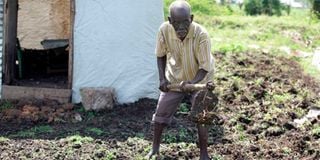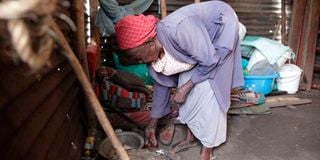
Some of the houses submerged in flood waters in western Kenya.
| File | Nation Media GroupKisumu
Premium
Depth of devastation: Displaced by floods, ‘Victoria villagers’ live on the edge
What you need to know:
- Waterborne diseases are on the rise and the people are playing hide-and-seek with hippos right in their villages.
- In Ogenya sub-location, residents are in dire straits while in Anyuro, about 150 households need urgent help.
It’s almost two years since the rising waters of Lake Victoria displaced thousands of Kenyans. The socio-economic ramifications of the phenomenon have not been fully examined and the aid extended to the victims has finally dried up.
The government left them to their own devices and they only cling to the forlorn hope that the waters will subside so they can reclaim their homes from the bed of the lake.
Their desperation is frightening. There was poverty before the rise of the waters but it was bearable, the present situation is much below poverty.
Waterborne diseases are on the rise and the people are playing hide-and-seek with hippos right in their villages.
Graves washed away
Old graves have been washed away and the new dead have to beg for burial space, schools have had to be relocated to higher grounds to the disadvantage of the children.
This is but just a glimpse of the chaos and human pains that have assailed the locals.
Plentinus Miruka is an octogenarian counting his losses after the worst floods in Kenya’s history swept away homes in Kanyagwal, Nyando Sub-county.
His one-acre parcel of land was submerged and his woes worsened when his wife and four children deserted him.

Mr Platinus Miruka 80, digs outside his makeshift house at Nduru Village in Nyando, Kisumu County on April 22, 2021.
Miruka still wistfully points at the place where he had his land. Ironically, you cannot see the land. “Other than losing my only cow and a dozen of chicken in November 2019, my family left. I now rely on relief supplies,” he said.
When the Nation caught up with him at his shack along the shores of the lake, the blank stare of the frail-looking man partially told his sad tale.
“I am now a homeless man. I depend on well-wishers who gave me a temporary shelter for basic needs,” said Mr Miruka.
About a couple of kilometres away, Wilfrida Okoth, 84, is going through a similar experience.
Villagers displaced
She was among hundreds of villagers who were displaced when River Nyando broke its banks and flooded their houses, sweeping away all their belongings.
Now a squatter, Ms Okoth has partitioned her shanty into three: One corner holds most of her items, another is the cooking area with the rest acting as the ‘bedroom’.
“This has been my home for two years. We are just praying for a miracle that the water will subside so we can reclaim our land,” said Ms Okoth, who moved from Ogenya to Kakola sub-location.
Locals say this is the worst situation since 1963 when floods wreaked havoc on small villages. The lake hit a new record level of 13.42 metres in 2019, slightly higher than the 13.41 metre mark recorded in 1964.
There’s widespread desperation in the expansive Kanyagwal location, whose entire population was affected by Mother Nature.
The people are in need of maize flour, cooking oil, wheat flour, blankets and mosquito nets and other essentials.
Area chief Boniface Nyandeje appealed for aid, saying hundreds of families face starvation after over 600 acres of cropland in Ogenya and Anyuro sub-locations were destroyed.
He said 684 families were yet to return to their homes, adding that the short rains had threatened the livelihoods of some residents who had started resettling.
Crucial facilities
In Ogenya sub-location, residents are in dire straits while in Anyuro, about 150 households need urgent help. Crucial facilities such as dispensaries, markets and primary schools were affected.
“Our people have to walk for at least 5km to Kanyagwal dispensary as malaria and waterborne illnesses are being reported,” he said.

Wilfridah Okoth, 84, at her makeshift house at Nduru Village in Nyando, Kisumu County on April 22, 2021.
There’s also a fresh human-wildlife conflict. Kakola Ward administrator Emmanuel Awich said hippos roam along the shores of the lake.
“Due to safety issues, locals are forced to be in their houses by 8pm to avoid animal attacks,” said Mr Nyandeje.
“The worst happens when a family member dies as relatives have to beg for burial spaces. Over 10 people have died in the last two years and have been buried by friends and relatives in higher grounds.”
Lake Victoria is a huge trans-boundary body shared by Kenya, Tanzania and Uganda and about 23 rivers feed the water body.





